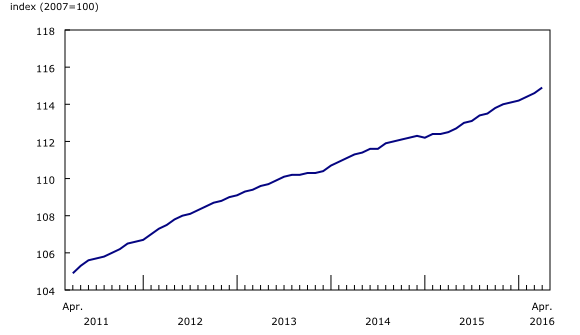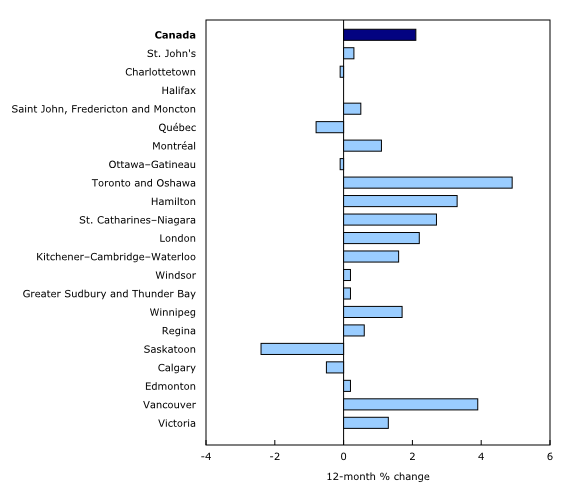New Housing Price Index, April 2016
Archived Content
Information identified as archived is provided for reference, research or recordkeeping purposes. It is not subject to the Government of Canada Web Standards and has not been altered or updated since it was archived. Please "contact us" to request a format other than those available.
Released: 2016-06-09
April 2016
0.3% 
(monthly change)
April 2016
0.0%
(monthly change)
April 2016
0.1% 
(monthly change)
April 2016
0.0%
(monthly change)
April 2016
0.0%
(monthly change)
April 2016
0.0%
(monthly change)
April 2016
0.5% 
(monthly change)
April 2016
0.1% 
(monthly change)
April 2016
-0.2% 
(monthly change)
April 2016
0.0%
(monthly change)
April 2016
0.3% 
(monthly change)
The New Housing Price Index (NHPI) rose 0.3% in April, following a 0.2% increase in March. This was the largest monthly advance since October and was mainly driven by new housing prices in Ontario.
Of the metropolitan areas covered by the index, the top contributor to the national increase in April was the combined region of Toronto and Oshawa (+0.7%). Builders cited market conditions as the main reason for the advance.
The largest monthly price gains in April were observed in Kitchener–Cambridge–Waterloo and Victoria (both +0.8%). Builders in both metropolitan areas reported market conditions as the primary reason for the increases. This was the largest monthly price advance in Victoria since May 2007, and the largest in Kitchener–Cambridge–Waterloo since June 2012.
Other significant price gains were observed in St. Catharines–Niagara (+0.7%) and Vancouver (+0.2%). Builders in St. Catharines–Niagara reported higher material and labour costs as the main reasons for the rise, while builders in Vancouver cited market conditions.
Prices were unchanged in 8 of the 21 metropolitan areas surveyed. New home prices have been flat in Edmonton, and unchanged or falling in Calgary for five consecutive months.
New housing prices fell 0.2% in Saskatoon and in Windsor. Builders in both metropolitan areas cited market conditions as the main reason for the decreases. Prices have declined in Saskatoon for eight consecutive months.
New Housing Price Index, 12-month change
The NHPI increased 2.1% over the 12-month period ending in April, the largest advance at the national level since February 2013.
The combined metropolitan region of Toronto and Oshawa (+4.9%) was the top contributor, recording the largest 12-month price increase in April. This was the largest year-over-year price gain in the region since October 2012.
Other notable increases were observed in Vancouver (+3.9%), Hamilton (+3.3%), St. Catharines–Niagara (+2.7%), London (+2.2%), Victoria (+1.3%) and Regina (+0.6%). Year over year, new home prices in London have risen for four consecutive months. This was the largest 12-month price advance in Victoria since April 2008, and the first in Regina since October 2014.
Among the 21 metropolitan areas surveyed, 5 posted year-over-year price declines in April: Saskatoon (-2.4%), Québec (-0.8%), Calgary (-0.5%), Ottawa–Gatineau (-0.1%) and Charlottetown (-0.1%).
Note to readers
The New Housing Price Index (NHPI) measures changes over time in the selling prices of new residential houses agreed upon between the contractor and the buyer at the time of the signing of the contract. It is designed to measure the changes in the selling prices of new houses where detailed specifications pertaining to each house remain the same between two consecutive periods.
The survey covers the following dwelling types: single dwellings, semi-detached houses, and townhouses or row homes. The survey also collects contractors' estimates of the current value (evaluated at market price) of the land. These estimates are independently indexed to provide the published series for land. The residual (total selling price less land value), which mainly relates to the current cost of the structure, is also independently indexed and is presented as the estimated house series. The NHPI is available at the national and provincial levels and for 21 metropolitan areas.
The prices collected from builders and included in the NHPI are market selling prices less value added taxes, such as the Federal Goods and Services Tax or the Harmonized Sales Tax.
The NHPI is not subject to revision and is not seasonally adjusted.
Infographic: Producer Price Indexes at a Glance
The infographic, "Producer Price Indexes at a Glance," which is part of Statistics Canada — Infographics (11-627-M), is now available. This infographic demonstrates how producer price indexes for goods and services are calculated and why they are important for the Canadian economy.
Next release
The NHPI for May will be released on July 14.
Contact information
For more information, or to enquire about the concepts, methods or data quality of this release, contact us (toll-free 1-800-263-1136; 514-283-8300; STATCAN.infostats-infostats.STATCAN@canada.ca) or Media Relations (613-951-4636; STATCAN.mediahotline-ligneinfomedias.STATCAN@canada.ca).
- Date modified:



